

Tankönyvbázis. Montessori ötletek - otthonra (1. rész) - OkosBaba. Ma már természetes, hogy az óvodákban gyermek-méretű bútorok találhatók, és fejlesztő játékokkal játszhatnak a gyerekek.
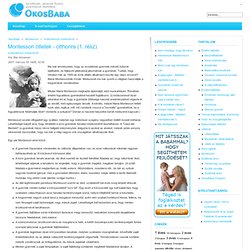
5 Top Trends in Education - Parenthood.com. What’s Hot and What’s Not In Education Today By Judy Molland From holding a kindergartner back a year to lengthening the school day, here are the education trends grabbing headlines and prompting debate as we head into a new academic year.
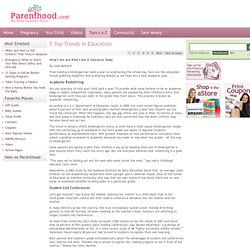
Academic Redshirting Are you planning to hold your child back a year? To provide what some believe to be an academic edge in today’s competitive classrooms, many parents are postponing their children’s entry into kindergarten until they are older in the grade than their peers. Starting out right: pre-k and kindergarten: full report. What’s the best early childhood education combination communities can provide?
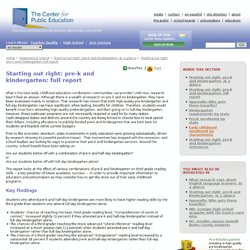
Until now, research hasn’t had an answer. Although there is a wealth of research on pre-k and on kindergarten, they have been examined mainly in isolation. That research has shown that both high-quality pre-kindergarten and full-day kindergarten can have significant, often lasting, benefits for children. Therefore, students would benefit most from attending high-quality prekindergarten, and then going on to full-day kindergarten. However, these particular programs are not necessarily required or paid for by many states. Prior to the economic downturn, state investments in early education were growing substantially, driven by research showing its powerful positive impact. What Are the Different Types of Alternative Teaching Methods? There are really a lot of advantages to homeschooling.

Many parents that are not happy with the school district in their area might consider this option. I actually taught both of my children how to read before they started school and it was really gratifying. I think that because a parent can give undivided attention and can customize the curriculum to fit their child’s learning style that children might actually learn more than in a traditional classroom. 5 Alternative Teaching Methods. Traditional schools "“ with their lectures, homework, and report cards "“ aren't for everyone.
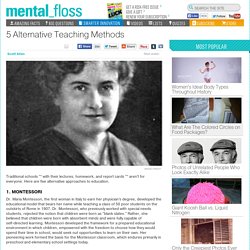
Here are five alternative approaches to education. 1. Montessori Dr. Maria Montessori, the first woman in Italy to earn her physician's degree, developed the educational model that bears her name while teaching a class of 50 poor students on the outskirts of Rome in 1907. Montessori believed that children enjoyed and needed periods of long concentration and that the traditional education model, with its structured lessons and teacher-driven curriculum, inhibited a child's natural development.
Montessori classes typically span three-year age groups. The lack of grades, tests, and other forms of formal assessment helps ensure that classes remain non-competitive. 2. The curriculum that defines the Waldorf method has remained relatively unchanged in the last 90 years. Sudbury school. At a Sudbury school, students have complete responsibility for their own education, and the school is run by direct democracy in which students and staff are equals.[1] Students individually decide what to do with their time, and tend to learn as a by-product of ordinary experience rather than through coursework.
There is no predetermined educational syllabus, prescriptive curriculum or standardized instruction. This is a form of democratic education. While there is no accepted definition of a Sudbury school,[2] the intended culture within a Sudbury school has been described with such words as freedom, trust, respect, responsibility and democracy. The Montessori Method. Montessori for Everyone - Montessori Blog. The Montessori Great Lesson Page. My name is Barbara Dubinsky.

I have been involved in the Montessori community for 30 years, through my own children, as an assistant, administrator, Lower Elementary teacher and now as a trainer. Fourteen years ago, I joined the movement of Montessori into the public schools - a most exciting expansion. I teach at a magnet school in Charlotte, NC. It is both challenging and ever so rewarding at the same time. Our school is given much freedom to do what we need to do as Montessorians; we have fought fiercely to have this freedom and have proven that what we do is the best system for children. Printable Montessori materials for learning in the home and at school - Free Montessori Materials.
DIY Number Rods and Alternatives. I had never thought about making Montessori number rods until I discovered some amazing examples online.
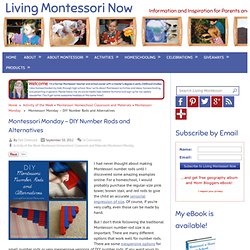
For a homeschool, I would probably purchase the regular-size pink tower, brown stair, and red rods to give the child an accurate sensorial impression of size. Free Montessori Downloads: Materials and Montessori Theory. Audio Language LessonsThis series of talks provides some of the basic theory behind the language program in the 3-6 Montessori classroom and specific instructions on how to give language lessons, including presentations for all Maitri Learning card materials.

These are MP3 files that you can download for free below or you can order a CD by clicking here. You can read an overview of the Big Picture of Language Development by clicking here. As you listen, keep in mind that these presentations go in sequence. The talks for each assume that you have already given the lessons described in the previous sections.Note: Before a child can become a true master of our language, s/he he needs self-confidence, an organized mind, a knowledge (internal dictionary) of words, endless opportunities to practice speaking/using words, phonetic awareness (knowledge of the sounds/symbols in our language), endless opportunities to create/write words, and the desire to write/read.
Maria Montessori. Magyarországi Montessori Egyesület. Association Montessori Internationale. Montessori Materials Purpose. One of the things I did when I was in the Montessori homeschool co-op, was to put the following information together for the co-op parents.

I found this information online and adjusted it to show what we were doing. Because of this, the list will also include the Catholic Montessori materials we were using. Harkness table. Students and instructor seated around a Harkness table What I have in mind is [a classroom] where [students] could sit around a table with a teacher who would talk with them and instruct them by a sort of tutorial or conference method, where [each student] would feel encouraged to speak up.
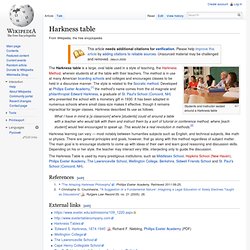
This would be a real revolution in methods.[2] Harkness learning can vary — most notably between humanities subjects such as English, and technical subjects, like math or physics. There are general principles and goals, however, that go along with this method regardless of subject matter. The main goal is to encourage students to come up with ideas of their own and learn good reasoning and discussion skills. References[edit] External links[edit] Waldorf-pedagógia.
Reggio Emilia approach. The Reggio Emilia Approach is an educational philosophy focused on preschool and primary education. It was developed by Loris Malaguzzi, who was a teacher himself, and the parents of the villages around Reggio Emilia in Italy after World War II.